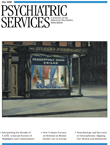Letter
Violence and Commitment to Treatment: Reply
In Reply: Dr. Large and his colleagues make several important points. In their study, individuals undergoing a first episode of psychosis were disproportionately more dangerous. This finding suggests that availability of hospitalization and other treatment is a critical factor if violent behavior is to be reduced.
The lack of available psychiatric beds for acutely ill patients in the United States is shocking. The Treatment Advocacy Center recently released a report indicating that this country has only one-third of the public psychiatric beds needed for minimally acceptable care; 51,413 beds exist and 147,233 are needed ( 1 ). In 32 of the 50 states, the psychiatric bed shortage was reported to be critical or severe. Without a sufficient number of available beds, it is impossible to adequately treat individuals undergoing their first episode of psychosis.
1. Torrey EF, Entsminger K, Geller J, et al: The Shortage of Public Hospital Beds for Mentally Ill Persons. Arlington, Va, Treatment Advocacy Center, 2008Google Scholar



